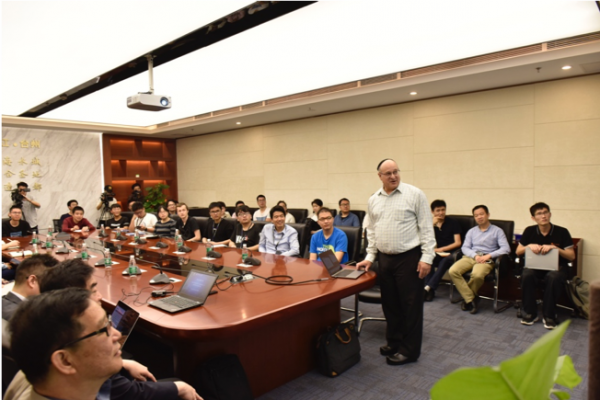The understanding of grain boundaries is critical for understanding changes in materials during things like corrosion, creep and precipitation. Earlier this month Professor David Srolovitz came to Southern University of Science and Technology (SUSTech) to give the 215th lecture in the SUSTech Lecture Series. He spoke on the topic of “Grain Boundary Dynamics: A Unified Perspective.” Professor Wang Xianglin from the Department of Materials Science and Engineering presided over the lecture.
Professor David Srolovitz is a Chair Professor and Senior Fellow of the Institute for Advanced Study at City University of Hong Kong, and the Professor of Engineering & Applied Science and Director of the Penn Institute for Computational Science at the University of Pennsylvania. He has authored about 500 papers on topics in materials science and simulations ranging from defects, microstructure evolution, deformation, and film growth. Professor David Srolovitz has been well cited, with an h-index of about 90 and more than thirty thousand citations throughout his career. He is a Member of the US National Academy of Engineering, a Fellow of MRS, TMS, ASM, the Institute of Physics and was the winner of the 2013 MRS Materials Theory Award.

Professor David Srolovitz started with a famous joke in material science: “Materials are like humans, and defects make them more interesting. Defects in materials are important factors affecting the structure and properties of materials, with grain boundaries making them a significant type of defect.” He was vivid in his explanation of an essential theory in material science called “grain boundary theory.”
David Srolovitz analyzed the mechanism of grain boundary motion from a kinetic and thermodynamic perspective. There are discontinuous atomic structures in the grain boundaries of materials under stress. These structures have high energy and will move to release energy in order to reach a stable state under further stress. The process of grain boundary movement is closely related to both stress and temperature. Molecular dynamic simulations show that at low temperature, due to shear stress generated during grain boundary movement, further movement of grain boundary will be gradually hindered until the external stress drives the grain boundary movement to start again, so the process of cycling and reciprocating is called “shear-migration coupling.” This proves that the motion of discontinuous structures in grain boundaries affects the shear and grain boundary migration processes of materials. At high temperatures, the coupling phenomenon is no longer obvious, and the shear and migration processes are no longer synchronized. Therefore, more complex factors are involved in the deformation and grain boundary movement of materials at high temperature.
David Srolovitz said that this generally applies to ideal bicrystalline materials (only two grains). In more practical scenarios, the shear coupling effect under external forces will generate stress and induce the rotation of grains to release stress, resulting in the growth of grains and the shrinkage and disappearance of some grains (the number of grains decreases).
Professor David Srolovitz took many questions after his lecture, with students and faculty members offering their unique perspective of this field.
Proofread ByMandi Zhu
Photo ByDepartment of Materials Science and Engineering